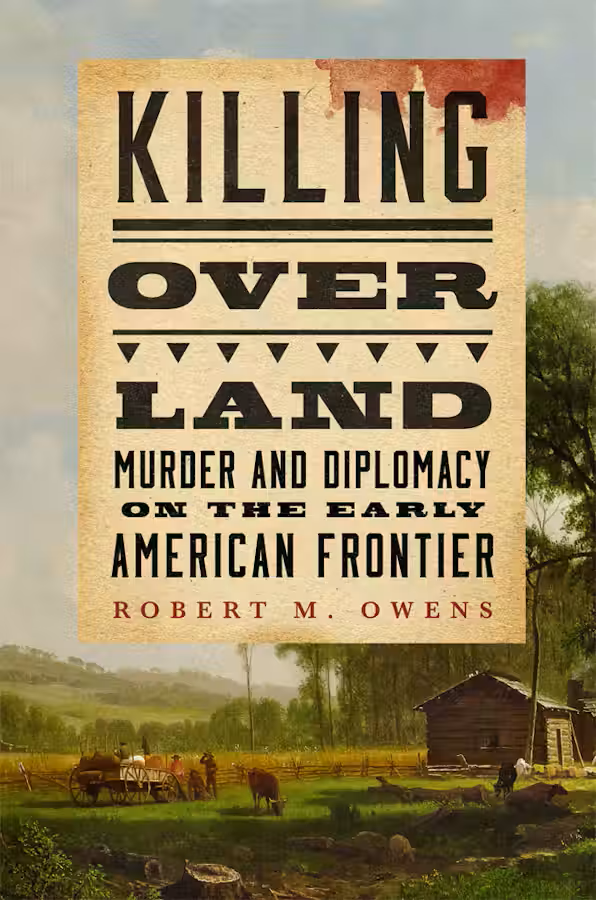
Robert M. Owens
Killing Over Land: Murder and Diplomacy on the Early American Frontier
University of Oklahoma Press, 2024
255 pages
$45.00
Reviewed by Lauren Bellatti
Tracing the history of interracial homicide in the United States, Robert M. Owens’s Killing Over Land: Murder and Diplomacy on the Early American Frontier argues that murders of Indigenous peoples by white settlers—and vice versa—provided not just an opportunity for retaliatory violence but also gave leaders an opportunity to improve intercultural relations, or at least profit from conflict resolution. In the seventeenth century, tribal nations tended to dictate the terms of these negotiations. However, as the white population grew and more land was seized in the eighteenth century, settlers began to have the upper hand. By the early nineteenth century, many Native leaders recognized that, with such an imbalance of power, the traditional practice of lex talionis—an eye for an eye—was no longer realistic. As a result, both Indigenous and settler leaders became increasingly willing to overlook murders if it led to some form of benefit, such as financial compensation or land cessions. Ultimately, the case studies Owens has assembled illustrate how the value of human life was increasingly treated as a commodity in exchange for maintaining a sense of order, as defined, contested, and accepted by both tribal and white authorities amid the escalating competition for land and resources during the European colonization of North America. Documenting these histories with such detail, Owens’s volume will prove to be a valuable asset for any American Studies scholar searching in the archive for examples of the ways in which violent crime, diplomacy, and dispossession of Indigenous lands constructed the physical and legal and landscapes of the early American frontier.
Arranged chronologically, this book is comprised of a series of fourteen concise chapters, almost reading like a short encyclopedia of eighteenth- and nineteenth-century frontier murders. Focusing on the administration of justice in colonial Pennsylvania, Georgia, and New Jersey, Owens begins Chapter One by contrasting the Quaker founding of Pennsylvania with the many border clashes that inevitably accompanied Georgia’s establishment as a buffer between South Carolina and Spanish Florida. In 1728 Pennsylvania, Deputy Governor Patrick Gordon offered a swift apology for John and Walter Winters’s murder of four Indigenous peoples along with a ceremonial burial, prioritizing diplomacy. Acknowledging Georgia was a more violent space than Pennsylvania, Owens then highlights how British officials in Georgia opted for negotiation over retaliation, seeing every interaction with tribal peoples as an opportunity to seize or cede land. New Jersey, however, inflicted capital punishment regardless of race, setting a legal precedent. Owens devotes the majority of space in this chapter to close reading the legal documents that the colonial leaders created to justify their differing responses to these homicides. The remaining chapters adhere to this same formula—close reading legal and real estate documents in quick succession—largely relying on the reader to draw their own connections about how the history of land acquisition both shaped and were shaped by the killings Owens has chosen to spotlight.
It is also worth noting that Owens frequently uses the term “Indians” when referring to Indigenous peoples. Phrases like “diplomatic relations between Indians and whites” or “Indians killing whites, whites killing Indians” appear on the first page of Owens’s introduction and continue to populate the proceeding pages of Killing Over Land. There is not, however, any moment where Owens accounts for his choice to use “Indians” over more conventional academic parlance like “Indigenous peoples.” Such an omission precludes any discussion of the term’s colonial and racist associations, leaving a significant gap in analysis given both the subject matter of this book and the cultural purchase of the word “Indian.” In the introduction to Redface: Race, Performance, and Indigeneity (2024), Bethany Hughes asserts that:
Indians do not exist. Indigenous peoples exist. Peoples with national, tribal, band, or community belonging exist. Peoples with relationships and obligations to land, water, and nonhuman relatives exist. Peoples with history, kinship, governments, and futurity exist. Indians do not. Indians are a theoretical and ideological construction, a construction possessing indisputable power that creates and explains undeniably material conditions for Indigenous and non-Indigenous peoples.
While the US government still uses ‘tribal people’ and ‘American Indians’ interchangeably, Hughes’s perspective appears to be more closely aligned with that of Indigenous people themselves. In 2023, the organization that was once known as the Native American Journalists Association changed its name to the Indigenous Journalists Association (IJA). Announcing the name change in a press release on August 11, 2023, the IJA explained that their members “thoughtfully considered a name change to be more inclusive of Indigenous journalists globally” and a “long overdue” step towards Indigenous journalists “taking their place as the rightful storytellers of their own narratives.” Language, as Owens does point out when discussing complicated executions of justice by white settlers on the early frontier, has distinct material consequences. Thus, the book’s overall project might have been enhanced if the historical and cultural—and, consequently, political—implications of the words scholars employ to discuss Indigeneity had been addressed with the same level of care and copious detail with which Owens recounts the facts of the murder cases themselves.
Through the brief yet meticulous discussions of violence included in his compendium, Owens demonstrates the myriad of ways that interracial murders on the early American frontier not only furthered the American settler colonial project and created the blueprint for the US’s future relations with tribal nations—including the advent of the Bureau of Indian Affairs—but also forged the diplomatic framework that would inform American imperialism through the nineteenth and twentieth centuries. While it may lack a level of intersectional analysis, this monograph is assiduously researched. Thus, Killing Over Land: Murder and Diplomacy on the American Frontier expands readers’ understanding of the role intercultural homicide played in stoking racial tensions and inciting wars while also demonstrating how white settlers used violence as a vehicle for establishing diplomatic relations and could prove a useful resource for scholars seeking to construct multifaceted or alternative histories of the violence inherently embedded in the project of American empire.

